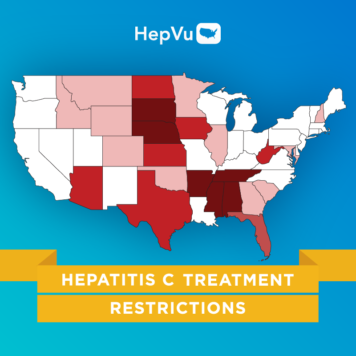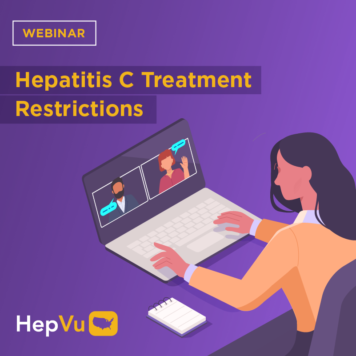Daniel Raymond is the Director of Policy at National Viral Hepatitis Roundtable (NVHR) and Phil Waters is a Staff Attorney at the Health Law and Policy Clinic in the Center for Health Law and Policy Innovation (CHLPI) at Harvard Law School.
Q: Can you explain the history of viral hepatitis treatment restrictions in the U.S.? Can you expand on the different types of restrictions in Medicaid?
Daniel Raymond: Medicaid systems provide health coverage to low-income people and are managed by each state. States have often created restrictions for access to certain expensive, specialty drugs within their system. These restrictions really came to light when highly effective and curative agents, known as direct-acting antivirals (DAAs), were introduced to treat Hepatitis C nearly a decade ago.
The state Medicaid systems looked at a couple of things: efficacy, cost, and patient population for the new DAAs. First, they analyzed the efficacy (cure rates) of these DAAs and found that they were very high—nearly everyone completing treatment would be cured. Second, the price was high relative to previous treatments. Third, state Medicaid officials expected that a large number of Medicaid beneficiaries were waiting for these new treatments. Unfortunately, the majority of state Medicaid programs decided that they couldn’t afford to treat everybody at the same time, so they imposed restrictions to help funnel the anticipated large group of people who would seek treatment and control costs. That decision was primarily motivated by cost containment rather than patient benefit, evidence-based guidelines, or clinical considerations.
Phil Waters: There was even guidance from the Centers for Medicare and Medicaid Services (CMS) stating that these restrictions are mostly non-medically indicated restrictions limiting access to treatment. There are a lot of them, but we began tracking the three most significant restrictions in 2017: fibrosis, sobriety, and prescriber restrictions.
Fibrosis refers to the amount of damage that Hepatitis C has done to an individual’s liver and is measured on a scale of zero to four, with zero indicating no scarring of the liver and four indicating liver failure or cirrhosis (extensive liver scarring). One of the biggest changes that Medicaid programs made was creating a cut-off for fibrosis levels to limit treatment. For example, in Arkansas, you will not get treatment unless you’re an F3 or above, which is almost reaching cirrhosis level. It is telling people with a diagnosis of a deadly infectious disease that they can’t be treated until they get sicker. This undermines both individual health and public health because these people can continue to transmit the virus to others while waiting for treatment.
Sobriety restrictions require people to prove abstinence from drugs or alcohol before treatment can be approved. These restrictions also hamper our efforts to stop the spread of Hepatitis C because injection drug use is one of the primary ways in which the virus is transmitted. It is right to treat these people both from a moral and a public health perspective because they are more likely than others to spread Hepatitis C to others.
Finally, prescriber restrictions limit what kind of physician can prescribe treatment in the Medicaid program, usually limiting it to a specialist or at least prescribing only in consultation with one. Specialists can be gastroenterologists, infectious disease physicians, or hepatologists. This restriction puts a strain on the system and creates a bottleneck in places such as rural areas where only one or two physicians may exist that meet the qualification in an entire county or even the entire state.
All of these restrictions together block people from receiving treatment for Hepatitis C and also hinder our efforts to stop the spread of the virus. These restrictions are implemented via prior authorization protocols that require the prescriber to prove that the patient meets the state’s criteria for treatment, delaying the time it takes to get someone treated after diagnosis. One new indicator that we’re starting to track this year is states that have eliminated prior authorization from their Medicaid program, which means that patients don’t have to prove they meet the criteria or submit a form to get authorization for treatment. Providers can treat anybody that needs treatment – in those states, we have paved the road to treatment and that’s something we love to uplift.
Q: The 2021 Hepatitis C: The State of Medicaid Access report from NVHR and CHLPI underscores the need to eliminate treatment restrictions as a “necessary step towards ending Hepatitis C in the United States.” How do treatment restrictions vary across the states, and how have restrictions eased across the country since the first report in 2017?
Phil Waters: We have made a lot of progress to date. The restrictions vary across the country, but things have certainly moved in the right direction since we started tracking in 2017. Since 2017, 32 states have either eliminated or reduced their fibrosis restrictions, 21 states have eliminated sobriety restrictions, and 25 states have scaled back their prescriber restrictions. I’m happy to say that right now, only four states have fibrosis restrictions in place, thanks to continued legal and community advocacy.
We’re hopeful that by the end of this year, the number of states with fibrosis restrictions reduces to three at the very least. Unfortunately, sobriety restrictions are the most common limitation we still see – 13 states still mandate some period of sobriety prior to treatment initiation. Meanwhile, 15 more states require their providers to ask patients about past or current substance use disorder and treatment status.
Prescriber restrictions still vary across the country. There are only two states that still require a specialist, while 16 states require a consultation with a specialist. However, about 34 states now allow any physician to prescribe treatments. As mentioned earlier, we also have seven states that don’t require any prior authorization at all. Looking at all of this progress, I believe we’re moving in the right direction.
Daniel Raymond: There’s a great momentum building here among the states. We’re actively encouraging states to revisit their restrictions to eliminate or scale them back. Much of this progress is because advocates use resources like the State of Hep C Report to understand the problems, talk to clinicians and patients in their community, and tell their state Medicaid programs to reconsider their restrictions because they are stigmatizing and not serving the interests of the state or the patients. For the past few years, states are recognizing that Hepatitis C treatment is no longer a significant driver of overall expenditures, and smart states are recognizing that more Hepatitis C-cured patients translate into lower health care costs for liver disease down the road. There are a lot of states we previously didn’t think of as being open to change, where we have actually seen tremendous progress. We now have several states, such as California, Indiana, Louisiana, Michigan, New York, Washington State, and Wisconsin acting as leaders in this space.
Q: The report calls out sobriety restrictions as a discriminatory policy that increases stigma. Why should we increase access to Hepatitis C treatment and harm reduction services to people who use drugs or alcohol?
Phil Waters: When we look at the major epidemiological surveys of people with histories of injection drug use, on average, over half of them have acquired Hepatitis C at some point in their lives. It’s very easily and commonly spread through injection drug use. The lack of drug treatment and adequate harm reduction services, such as expanded and accessible syringe services programs, contributes to this continuous Hepatitis C transmission.
Hepatitis C prevalence in communities that have been hard hit by the opioid epidemic creates additional burdens and pressures on different systems such as the healthcare and criminal justice system. On an individual level, there’s an interesting dynamic between stigma around substance use and stigma around Hepatitis C. Whether or not a person with a history of drug use has Hepatitis C, they will still experience the stigma that there’s something contagious about them. Conversely, whether or not an individual with Hepatitis C acquired it from injection drug use, any bias against people who use drugs will spill over to all people with Hepatitis C regardless of the source of their infection. This is an example of discriminatory action. There are very high cure rates and successful treatments for people living with Hepatitis C if they receive proper care, no matter if they are current or recovering users of drugs. These Medicaid restrictions deny both the agency and capacity of people who use drugs and their healthcare providers to make appropriate decisions about their health and their care.
Daniel Raymond: The misconstrued idea that Hepatitis C medications are so expensive and scarce that access should be restricted to those who can maintain sobriety feeds into an exaggerated fear of a “wasted” course of treatment if someone subsequently gets reinfected. This misconception has led clinicians to substitute their biases for an informed review of the evidence-based research, which indicates that re-infection rates, even among people who continue injecting drugs, remain acceptably low. This misguided fear can also prevent access to care by allowing some healthcare settings to impose these stigmatizing sobriety restrictions until the patient is fully abstinent.
Q: The report outlines the importance of collective leadership and resources to ensure all individuals living with Hepatitis C in the U.S. can access the proper treatment. What are the next steps in removing or reducing treatment barriers?
Phil Waters: Removing treatment barriers is a necessary, but not sufficient, condition to eliminating viral hepatitis. Next steps should be dedicated funding and programs to raise awareness about Hepatitis C treatment and cure among patients and providers. Harm reduction services and other integrated services also should be developed and implemented to end the viral hepatitis epidemic. In terms of removing restrictions, we’ve put out a call for the Department of Justice (DOJ) to enforce the Americans with Disabilities Act (ADA) in the context of sobriety restrictions. The ADA prohibits discrimination based on recovery from drug/alcohol use and in the context of health care services, prohibits discriminating against active users when seeking public health care. Thus, it is our position that sobriety restrictions discrimination against individuals with a disability (substance use disorder (SUD) and/or active drug or alcohol use) and must be removed. We’re hoping to work with them to make progress in the next year.
Daniel Raymond: We see opportunities for collective action on a few fronts. Earlier this year, the Department of Health and Human Services (HHS) released its new Viral Hepatitis National Strategic Plan, committing to viral hepatitis elimination in the U.S. by 2030. That goal means that we’ve got to really take a focused and urgent look at the barriers threatening to leave some people behind. It also gives advocates an opportunity to reengage both states and the federal government, such as the CMS, to push for meaningful and concrete steps to make viral hepatitis elimination a reality.
The national plan highlights areas where we are falling behind. One of the biggest issues is the rising Hepatitis C infections among young people who inject drugs. To solve this issue, we need a combination of more harm reduction services, increased access to medications for opioid use disorder, as well as streamlined entry and completion of Hepatitis C treatment without restrictions. We have already seen the White House take action on increasing access to medication for opioid use disorders and signaling support for expanding harm reduction. The third leg of this stool is the role that the administration can play in pushing states to reassess and remove remaining barriers in access to treatment through Medicaid.
Q: How can other advocates, providers, and patients use the report in their work to eliminate Hepatitis C treatment restrictions and expand access to care?
Daniel Raymond: A lot of government officials are shocked after seeing the current state of treatment restrictions across the states. The report should serve as a wake-up call that this is not a settled issue. This is not behind us. Putting the maps on HepVu means that advocates also now have access to county-level mortality data to compare them against, and that presents a very powerful visual regarding problems, barriers, and solutions. The report and HepVu’s maps are additional tools in advocates’ toolbox to build their case against treatment restrictions.
Phil Waters: One way to use the report is to point out how your state is doing compared to the other states and the nation as a whole. It’s particularly effective in getting your state officials to pay attention to any issue because nobody wants to be at the bottom of a list on anything. Showing state governments what they can do to get in step with other states using our materials can help expand access to care.
For federal advocates, the collective message is that we’ve been doing this for a while now. We’ve been removing restrictions for a while, but there are still some holdout states. We also need some pressure at the federal level to make that final push and get the remaining restrictions removed. Showing the federal government this story from 2017 to 2021, how far we’ve come, and how there’s still more work to be done, is a very powerful message.




